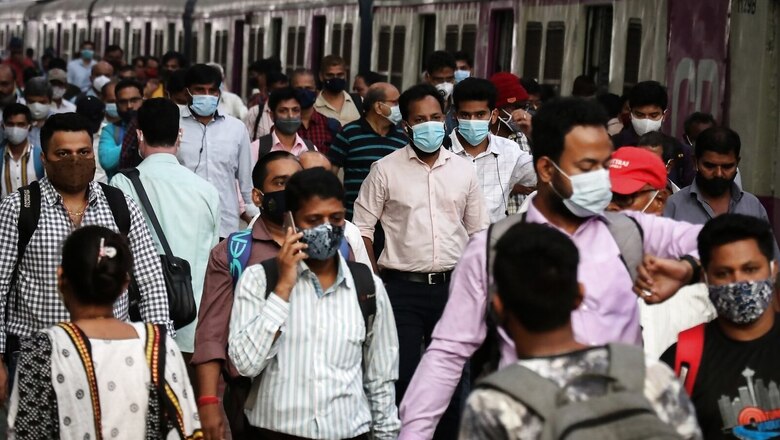
views
A "tremendous" rise in the number of Covid-19 cases in Mumbai is driving a surge in new infections in Maharashtra over the last few days, data showed, with a top official expressing fear that the approaching monsoon could herald a spate of symptomatic cases. Maharashtra had recorded 169 new cases on May 1, while on May 31 the daily rise in cases in the state was 711. Of 9,354 cases added by the state in May, 5,980 cases, or nearly 64 per cent, were contributed by Mumbai, data showed.
In a worrying sign, the Dharavi area of Mumbai, among the densest urban sprawls in the world, on June 1 recorded 10 cases, taking its active count to 37. The Brihanmumbai Municipal Corporation (BMC) had received praise from the World Health Organization during the earlier phases of the pandemic for successfully containing the spread of the virus in the area where over six lakh people live.
On Wednesday, Mumbai municipal commissioner Iqbal Singh Chahal asked officials to ramp up testing on war-footing and also keep staff at `jumbo' Covid hospitals on alert amid the steady climb in the number of infections. "The new cases (reported) daily have gone up tremendously in Mumbai, and with monsoon round the corner, we will now see a rapid rise in symptomatic cases," Chahal told BMC officials.
On Tuesday, the daily addition to the caseload went beyond the 500-mark for the first time since February 6, while a sharp spike was seen the very next day when 739 new cases came to light. Health experts are stressing that pandemic norms like wearing masks and social distancing, which were rolled back to "voluntary mode" on April 2 this year amid a fall in cases, will have to be observed diligently again.
"The rise in cases could be due to multiple reasons. Vaccination coverage has slowed down and is poor in the under-18 and booster dose segments. Moreover, the virus undergoes mutations to form new variants that are either more transmissible, or the immunity acquired by vaccination does not fully protect against them," said Dr Trupti Gilada, Infectious Diseases specialist at the city's Masina Hospital.
"But, in this relatively immune population, the symptoms are still milder. Therefore, there is no reason to panic since there is no increase in hospitalisations or deaths despite the rising number of cases," Gilada pointed out.
She also said the pattern observed in these cases is not very different from what is seen in other respiratory viral illnesses like influenza, with a minor surge being seen every few months. "We should focus on ramping up vaccination, both for those below 18 years and the administration of booster doses. The mandatory gap between the second dose and booster dose should be six months rather than the current nine months. With close to 20 crore vaccines lying with states and nearly three crores with Maharashtra alone, boosters should be made free for those eligible and who are willing, Gilada said.
Dr Laxman Jessani, the infectious diseases specialist at Navi Mumbai's Apollo Hospital, said new variants seem to be escaping immunity, which could be the reason behind the rise in cases. "More than 90 per cent (of newly infected persons) have received the first dose, but second dose and booster dose coverage is still not optimum. Infection control measures like masks, social distancing, and washing hands regularly need to be reinforced," Jessani asserted.
As of June 1, as per the state health department data, 16,68,98,518 Covid-19 vaccine doses have been administered in Maharashtra. As many as 22,28,678 first doses and 9,89,303 second doses were administered to those in the 12-14 age group. A total of 7,14,92,608 first doses have been administered to those between 15 and 59 years of age, while this segment has also been given 5,80,94,133 second doses and 2,68,043 precautionary doses.
The first dose has been administered to 1,33,65,415 people in the 60-plus segment, while the second and precautionary doses given to this senior citizens' group stood at 1,13,09,644 and 16,44,989, respectively. Dr Sanjith Saseedharan, consultant & head of Critical Care at Mahim's S L Raheja Hospital, said the rise in cases may be due to the presence of BA.4 and BA.5 variants and the growth advantage these may be possessing.
The state health department had announced on May 28 that for the first time, four patients of BA. 4 variant and three cases of BA. 5 variants of the Omicron sub-lineage of coronavirus had been found, all in Pune. "It is also important to note that this strain of the virus is not highly virulent, and might not cause an exponential rise in hospital admissions, including an increase in ICU cases. However, this may not be true for elderly patients with comorbidities who may require higher care, including hospitalisation. So we must continue to maintain social distancing and wear masks whenever possible, he said.
He also said the increase in mobility of the general population after the relaxation or removal of Covid-19 curbs could also be resulting in the rise in cases. Saseedharan, however, said the healthcare industry was now well-equipped to tackle a surge.
State health minister Rajesh Tope had recently said people in districts witnessing a spike must raise the level of caution and start wearing masks again.
Read all the Latest India News here


















Comments
0 comment